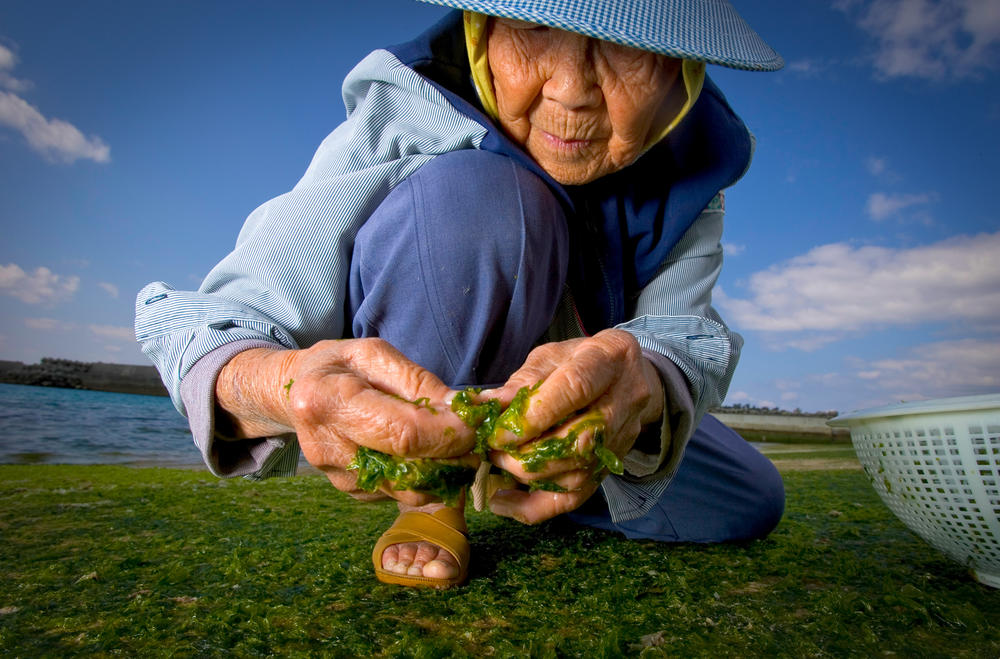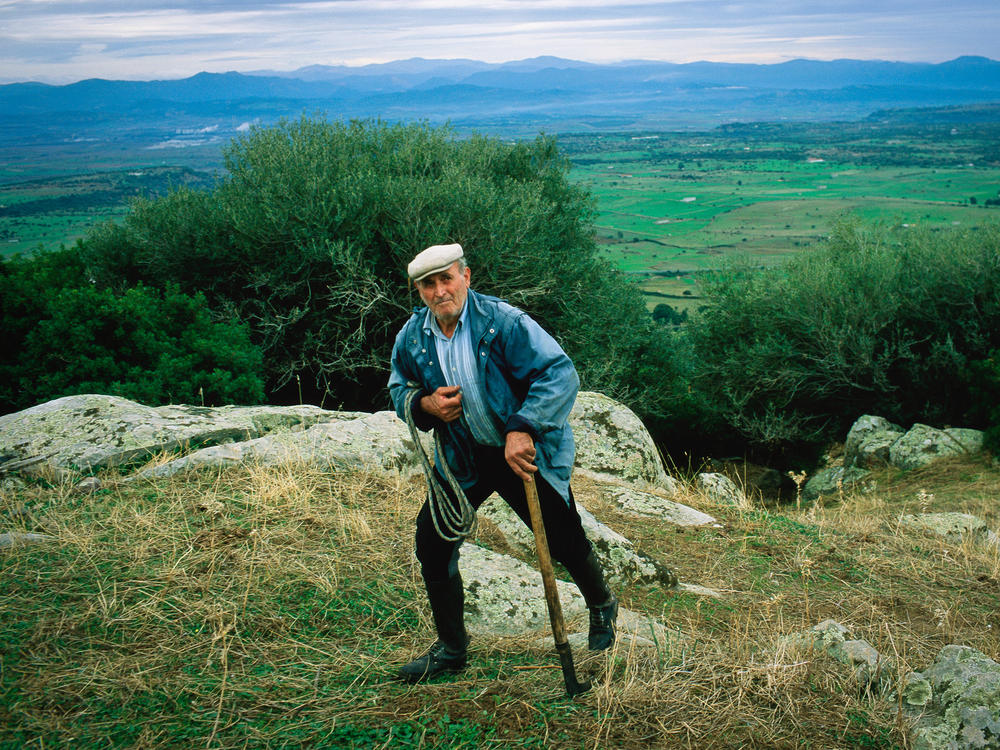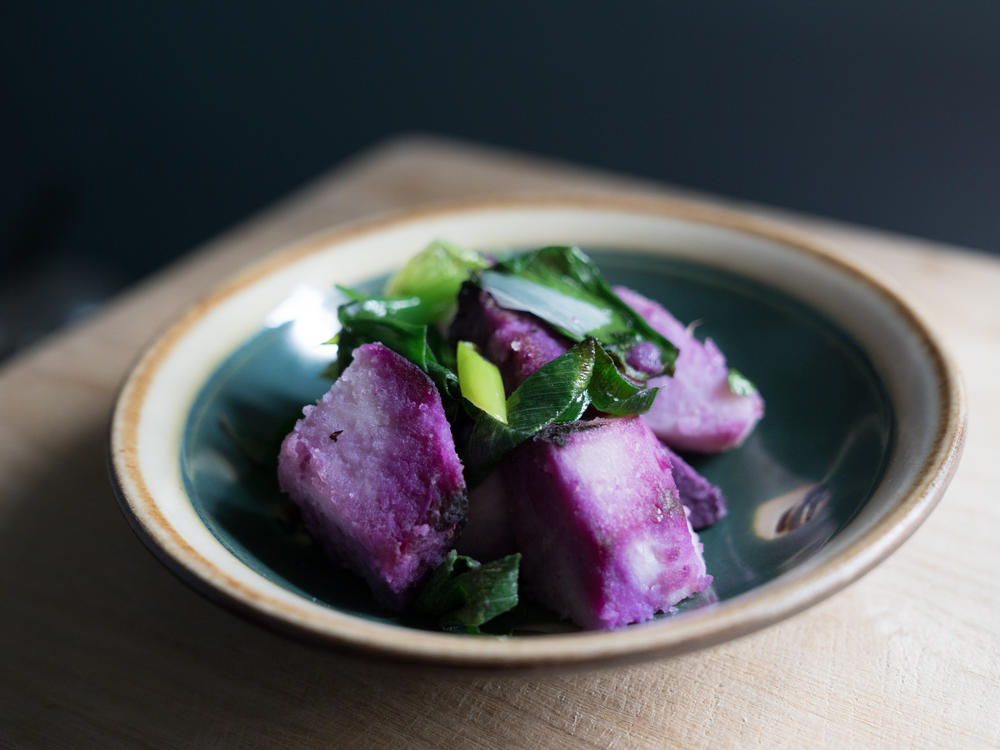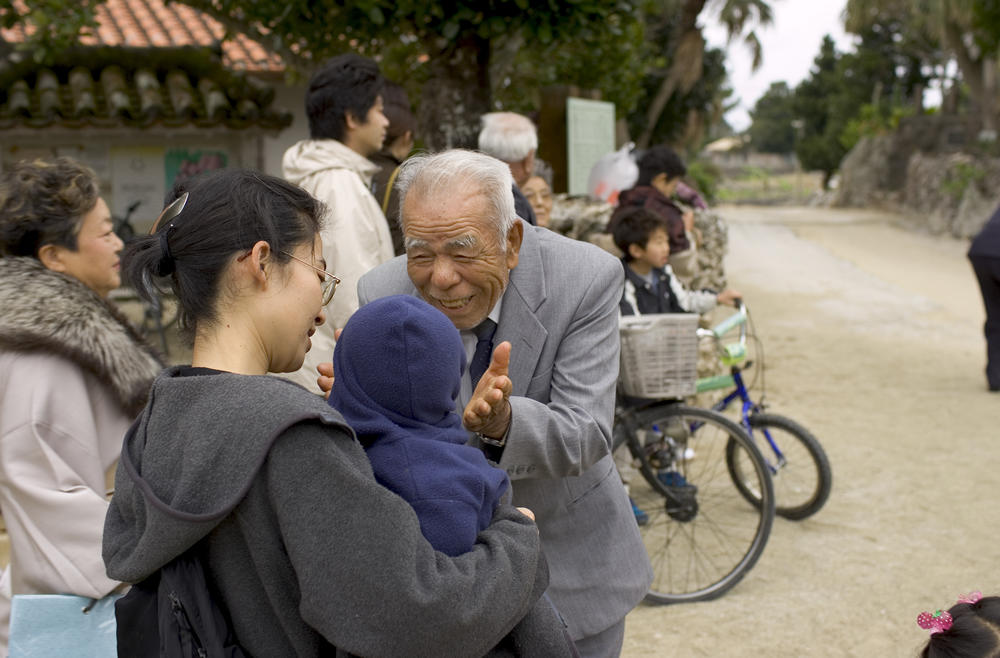Section Branding
Header Content
7 habits to live a healthier life, inspired by the world's longest-lived communities
Primary Content
At a time when life expectancy in the U.S. has dipped and diet-related disease is a leading cause of death, it's no wonder that Dan Buettner's decades-long exploration of centenarians who thrive in the longest-lived communities on Earth is attracting lots of attention.
His new Netflix documentary, Live to 100: Secrets of the Blue Zones, is trending as a top streaming pick. In it, there's an evocative scene, set against the backdrop of the turquoise waters and sugar-sand beaches of Okinawa, a subtropical archipelago about 1,000 miles south of Tokyo.
Compared with Americans, people in Okinawa are about three times more likely to reach their 100th birthday, according to Buettner's research. He introduces us to centenarians who garden, cook, sing, laugh and play. Their weathered skin and slow gaits don't stop them from living fully, albeit simply.
There are equally beautiful scenes from other long-lived communities, which Buettner calls "blue zones," including Ikaria, an island off the coast of Greece in the Aegean Sea, and the mountain villages of Sardinia, off the coast of Italy.
As a viewer and reader — The Blue Zones: Secrets for Living Longer is the companion book that Buettner has just published — I felt myself pining for their way of life.
For most of us, it's not feasible to swap places with these island dwellers, many of whom maintain a centuries-old, eat-from-the-land existence in remote corners of the globe. But we can learn from their simple habits and customs.
"People in blue zones, they're not thinking about their health or a diet or an exercise program. They're not doing anything except living their lives," Buettner says.
They are living longer without intentionally setting out to do so. He says they have unwittingly created an environment — through their habits, rituals and cultural norms — that promote health and longevity.
So after watching the documentary, reading the book and interviewing Buettner, here's my take on ways to swap old habits for new ones, based on the blue zone revelations.
Swap 1: Trade the La-Z-Boy for a mat and a garden
Build movement into your day. For those of you who don't like the gym, you may be inspired by the way people in the blue zones incorporate movement into their everyday routines. "Plant a garden in your backyard," Buettner says. "A garden nudges you to weed and water and harvest almost every day," and that keeps you moving, he says. Also, instead of lounging on chairs or sofas, emulate the Okinawans' approach to spending more time on the floor, either sitting or squatting.
"I sat for two days with a 104-year-old woman who got up and down off the floor 30 times," he recalls. That equates to 30 squats and helps maintain strength in the legs and core.
"It makes for better balance and flexibility and probably healthier backs and fewer falls," Buettner says. Falls are the leading cause of injury and injury death in people over 65 in the U.S., and these strategies could help prevent one.
Swap 2: Ditch DoorDash and eat like a peasant
Buettner describes meeting the oldest family in the world, whose collective age of nine siblings was 860 years (about a 95-year average). Their daily staple was a traditional Sardinian minestrone soup made from leftover garden vegetables, beans, a little barley, some tomatoes and a bit of olive oil. The Sardinians also eat a lot of whole-grain sourdough. "People in the blue zones are eating the cheapest peasant foods," Buettner says.
And while the blue zones he visits are distinct geographically, their diets are similar. The top five pillars of the blue zones' diets are whole grains, vegetables, greens, beans and tubers, such as sweet potatoes.
"A cup of beans a day is associated with an extra four years of life expectancy," Buettner says of his analysis. And people mostly cook their own meals. "There's no DoorDash in the blue zones," Buettner jokes.
People live a slower pace of life and use lots of herbs in their cooking. The Sardinians love rosemary. In Costa Rica's Nicoya region, cilantro is a favorite, and in Ikaria, fennel, oregano and sage are popular. "They know how to make their peasant food taste delicious, and that's the secret," he says.
Swap 3: Reduce meat and aim for a plant-forward approach
Buettner reviewed about 150 dietary surveys conducted in the blue zones over the last 80 years. "If you average them, more than 90% of their dietary intake comes from complex carbohydrates — whole plant-based foods," he says. For instance, Okinawans eat a lot of sweet potatoes, which are rich in vitamin A. And in the Nicoya Peninsula in Costa Rica, carotenoid-rich squash is a staple.
The typical diet in the U.S. includes about 220 pounds of meat per year, per person. In the blue zones, it's about 20 pounds a year: "About 1/10th of what we eat," Buettner says. There's just a little bit of cheese and a small amount of fish. In Okinawa, tofu is a staple and is often eaten twice a day, mixed with vegetables and herbs. And a key principle of eating there is to stop when you're 80% full.
One way to be aware of how much you're eating is to turn off the TV, put your devices away and save the dining table as a place to slow down and savor. Mindful eating has been shown to help people moderate their intake.
Swap 4: Give loneliness the boot — become a joiner
Costa Rica's Nicoya Peninsula is a blue zone that spans a 30-mile strip made up of pastureland and tropical forests. The climate is warm and sunny. People don't make much money, but the country's health care system is generous and men in the region are about three times more likely to live to 90 compared with men in the United States. As Buettner points out, its isolation from the rest of the world has helped stitch people together. "They rely on each other," Buettner says.
He describes meeting a woman named Panchita who was well over 100 years old. Each day, her 85-year-old son and his children biked to her house to help feed the chickens. In return, she cooked them some beans and some rice. "There's this beautiful symbiosis," he says. Not only do they put family first, but their customs and rituals bind them together. "They tend to be Catholic, so they show up to church. Festivals are a priority," he explains.
There's a similar prioritization of family and community in Loma Linda, Calif., home to a large concentration of members of the Seventh-day Adventist Church. It's one of the original five blue zones and the only one in the United States. (Initiatives aimed at leveraging the blue zone strategies to improve health are underway in communities around the United States.)
Adventists tend to hang out with other Adventists. The church gives them a foundation. "They have potlucks and [take] nature walks," Buettner says. Bottom line, they show up for each other, and they live about seven years longer than the average American.
If organized religion isn't your cup of tea, there are lots of ways to find community based on your interests, whether it's playing pickleball, joining a gardening or hiking club or getting involved in a civic project in your community.
Swap 5: Revamp social media to cultivate friends and a sense of purpose
"The best longevity hack is to curate your immediate social circle," Buettner told me. That doesn't mean dumping an old friend who has some unhealthy habits, but "they're probably influencing you in the wrong way," he says. Take a play from the Okinawan playbook, where they join small groups called moais to help support and encourage each other.
You can do this in your social media feed as well. One strategy is to curate your feeds so you're seeing content from people who share your interests and values. If someone makes you feel uncomfortable, say goodbye. Find people who "fill your bucket" and inspire you.
Over the years, I've written a lot about research that shows just how contagious our habits are. If you're happy and engaged, positive emotions can spread. If you aim to live a healthier life, your odds improve if those around you are committed too. So, try this blue zone principle of human behavior to help align yourself with people who can serve as a sounding board to help you live with purpose.
Swap 6: In lieu of an afternoon espresso, take a nap
When I gather with friends, the conversation often revolves around the zillion things keeping us busy. Between our work commitments, launching kiddos to college, caring for aging parents and travel, this busyness can be viewed as a status symbol. To push through these busy days, it's common to caffeinate rather than downshift. But this is the antithesis of a blue zone mindset.
The alternative: a cat nap for as little as 20 minutes in the afternoon. It's a habit that Buettner says he has adopted in his own life. In Ikaria, where it gets very hot, people tend to stay up very late, past midnight, often socializing, he says. Since they wake up late, a midafternoon siesta makes sense. "Almost all of them nap," Buettner says.
The siesta is an age-old tradition, of course. And though modern life has pushed it to near extinction, the most recent science shows that a 20-minute nap can make up for an hour of lost sleep and helps keep you sharp later in the day.
Swap 7: Trade big-city rents for an affordable home (and maybe keep your parent nearby)
For this swap, a lot of people may need some assistance, but consider how Singapore has helped its residents.
About 80% of people in Singapore own their home, which is an extraordinarily high rate of ownership. This is partly the result of a government policy to subsidize apartments, beginning decades ago.
Singapore is new to the list of blue zones. "Over the last 50 or so years, they've grown life expectancy by almost a quarter of a century, and they've done so by prioritizing people's health and well-being over just business interests," Buettner says. Singapore has adopted policies to promote health such as subsidizing food and prioritizing walkability in the city. "What you have is this very walkable, clean environment where healthier choices are easier," Buettner says. He points to another unique concept: a tax break for people who keep their aging parents close.
So though homeownership is out of reach for many Americans, especially in big cities, here's one strategy to consider: a move to a more affordable town, especially for young adults looking to put down roots.
There's no single change to create a culture of health. Moving the needle requires dozens of small steps and initiatives that can help nudge people toward better choices and make the healthier choice the easiest. Buettner acknowledges that the original blue zones are fading. The isolation of many of these communities has helped preserve the traditional way of life, but urbanization and the global economy are pushing people to more modern lifestyles.
We'd be wise to stop and take note. A body of scientific research validates the blue zone way of life: Good food, good sleep, good friends, plenty of movement and a sense of purpose are a recipe for living better.
Copyright 2023 NPR. To see more, visit https://www.npr.org.





